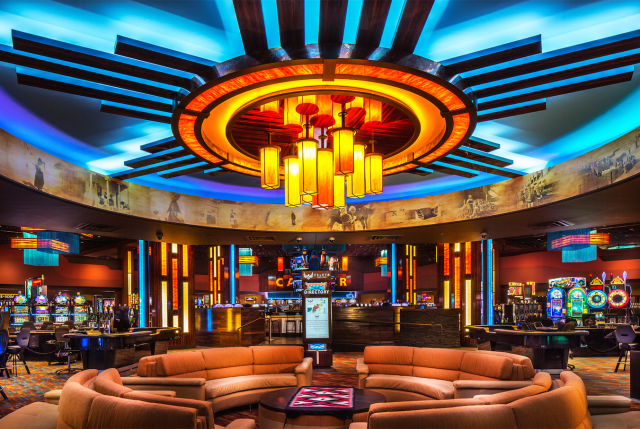
“Structures within structures” at the Isleta Casino & Resort, in Albuquerque.
Evolution of Casino Design
by Adam Samson
It’s no secret that casino operators employ certain strategies and techniques to keep their patrons spending, from the services that they offer right down to the interior design of the gaming floors. The bright lights, absence of clocks, etc., all set in a maze-like layout, are part of the psychological manipulation of players. Nevertheless, new research suggests that these stereotypical design features are no longer a priority for casino decorators.
This classic recipe for casino success was attributed to Bill Friedman, who studied the design elements of the most profitable establishments and elucidated the principles of “gaming” design – low ceilings, little decor beyond tables and machines, and a layout that somehow always leads you back to the casino’s gambling areas.
But that is changing. Now when people think of casino resorts, what immediately comes to mind is glamorous surroundings, even if the city itself isn’t that glamorous. While most new visitors expect a festive and animated atmosphere, they also look for luxury and want to feel welcomed by the design. No one wants to feel like they’re being tricked into gambling.
The shift from conventional casino design to David Krane’s “playground layout” design is reshaping the inner workings of casinos today, catapulting them into higher profits despite the violation of Friedman’s traditional principles. Studies show that gamblers responded more positively to varied color schemes, static lighting, symmetrical layouts and the clustering of machines by theme.
Furthermore, “the bigger, the better” for casinos no longer applies. One trend that seems to have sprouted over the last couple of years is a boutique ambiance, creating more intimate spaces within a big space by using what Paul Steelman, of the Las Vegas-based casino design firm Steelman Partners, calls “structures within structures.”
Another prominent trend that fellow designer Brad Friedmutter has observed is the use of layout to help the younger patrons interact with one another. [Editor’s note: Our imagination runs rampant. Some readers may not even want to know what that means!]
There has been a growing number of game apps offering the same style and approach. According to prominent mobile gaming software developer Gaming Realms, more than 70 percent of their gamers are now using mobile devices, which exceeds the industry average. The award-winning game developer of mobile casino software Pocketfruity adds that the proliferation of faster internet connections for mobile (4G) has led to more adoption of smartphones and tablets for gaming. At the end of the day, the most important thing is to give gamblers a seamless gaming and casino experience.
Although casino providers are constantly coming up with new ways to attract gamblers, the focus will always be on gambling. It’s just a matter of making gaming even more like play than like work.
Adam Samson is a freelance writer specializing in architectural design. He lives in Twickenham, U.K.
***
The author, Adam Samson, is an art enthusiast with a passion for old architecture, and hopes to learn the craft of restoration. Like me, he enjoys travel and walking around cities with his camera, taking photos of street scenes.
I take no position on whether the recent changes he describes in the interior design of casinos are good or bad. I am certain that however that may be, a gambling arena set in a building of traditional beauty is probably better for both players and owners than one set in a goofy modernist building. Perhaps author Samson agrees. But on second thought it occurs to me that modernist casinos might carry their own intrinsically baffling features, useful to fool gamblers into gambling in such places. Or might a confusing design cause gamblers to seek more alluring casinos? Any thoughts from readers?



I think you are the best writer i’ve ever seen in my life. thank you for the information. see you next time
LikeLike
Many people are interested in Keno for your opportunity to win significant coverall progressive jackpots or regarding high
paying Keno competitions.
LikeLike
Interesting parallel. I am aware that Vegas has been evolving so that families and not just gamblers will find things to do. The idea of malls transforming into streetscapes (already implicit in their conception) is full of interesting ramifications.
LikeLiked by 1 person
Interesting article! Being from Nevada originally, I am no stranger to casino design, but am interested to see how they evolve. I think the structures-within-structures idea is brilliant and may be reflected in the evolution of malls (looking more like small town main streets with boutique stores and theaters).
LikeLike